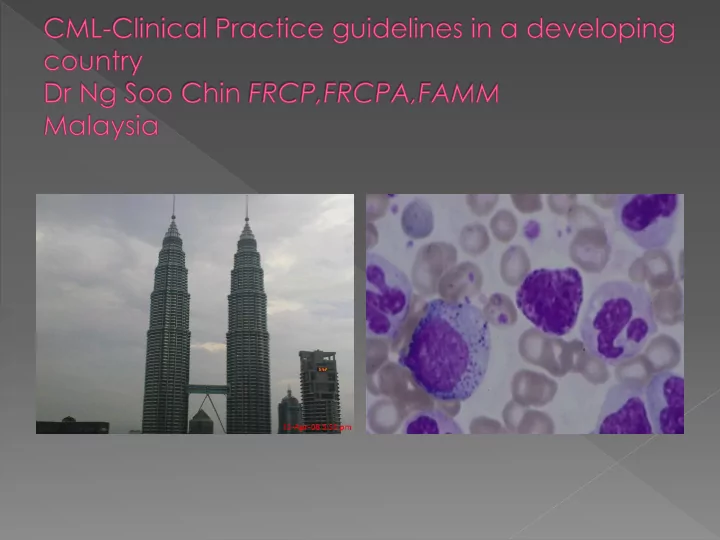

First human cancer Mother of noted to have cytogenetics aconsistent chromosomal abnormality Spectacular success Era of targeted of Glivec therapy
Year Total Dead 1.0 Imatinib 276 14 1990-2000 960 357 0.8 1982-1989 365 266 90% Proportion Surviving 1975-1981 132 127 1965-1975 123 122 0.6 0.4 0.2 0.0 0 3 6 9 12 15 Years From Referral The University of Texas M. D. Anderson Cancer Center database.
Parameter Historical Perspective Modern Perspective (Until 2000) (Since 2000) Course Fatal Indolent Prognosis Poor Excellent Median survival, yrs ≥ 25* 3-6 Allogeneic SCT, Frontline treatment Imatinib interferon alfa Second-line treatment Not established Allogeneic SCT, novel TKIs *extrapolated from imatinib mesylate Kaplan-Meyer data. Faderl S, et al. N Engl J Med. 1999;131:207-219. Druker BJ, et al. N Engl J Med. 2001;344:1031-1037.
Much of the practice guidelines in CML is IRIS TRIAL driven. Use of Glivec as the first line agent The decline of Haemopoietic stem cell transplant Pleasant surprises: late responses and annual risk of progression decreases with time
Annual Event Rates Over Time 10 Annual Rates (%) 8 6 4 2 0 1 2 3 4 5 6 Year All annual event rates include loss of CHR, MCyR, AP/BC, and death during treatment Hochhaus A, et al. ASH 2007. Abstract 25.
Imatinib Imatinib (n = 364) 400 mg/day* (n = 553) Crossover to Imatinib † Patients with (n = 359) chronic-phase CML Crossover to Interferon alfa (N = 1106) 5 million U/m 2 daily + Interferon † (n = 14) Cytarabine 20 mg/m 2 10 Interferon alfa/ days/mo Cytarabine (n = 553) (n = 13) *Increased stepwise to 400 mg BID allowed if no CHR at 3 months or > 65% Ph+ cells at 12 months. † Permitted for no CHR at 6 months, no MCyR at 12 months, loss of response, or treatment intolerance. Hochhaus A, et al. ASH 2007. Abstract 25.
Incidence (0.39-0.9 per 100,000) 7% to 15% of all adult leukemias Prevalence increasing because of marked improvement in treatment results
Age Financial considerations Compliances Infrastructure and manpower others
Most Asian CML patients have younger age of onset Pregnancy Long period of treatment Compliance issue ?more transplant option
182 patients: mean age of presentation 35 years ( Compared to 44 in western studies) SCNg and P kuperan Malaysian J Path01 1990; 12 (2): l l l Overall median age(36-46); USA (65)
Money is not everything –it’s the only thing
Malaysia: US 6948 Spore: US 30000 Indonesia: US 2271 Thailand: US 3737 USA: US 50000 Impossible for majority of Malaysian CML patients to afford glivec
If not for the hugely successful patient assistance program , Glivec will not be available for >90% of CML patients. 700 patients (300 private and 400 govern) Around 100 patients from East Malaysia.
Very few patients can afford 2 nd generation TKI. No assistance program to date. Care of BMT patients can be very costly if they develop severe GVHD. Follow up monitoring tests (esp cyto/molecular tests are pricey)
[Pix]
Outside the major towns, diagnostic, medical and supportive facilities may be lacking. Problems especially acute in inland part of East Malaysia
Cytogenetic services Molecular services: qPCR – not routine services. Mutation analysis Still lots of room for improvement Differences between research and routine services
Steady improvement over the years Haematology departments More trainees Active Malaysian Society of Haematology Still room to grow (30 clinical Haem/28 million)
Not sufficient for the growing population of 25 million 7 active centers (6 Uni/govern; 1 private) 1174 HSCT bet 1987 and 2006 BMT rate relatively low
Usual considerations: efficacy, safety, cost, compliance etc Need ministry of health endorsement Tripartite: MOS, MSH, Academy of Medicine
Lack of cyto/molecular testing Lack of BMT facilities Availability of Glivec and second generation TKI No mutation studies HSCT might be difficult to organize Patient compliance
At diagnosis Cytogenetic study and BCR/ABL qualitative study BM aspirate and biopsy
Glivec is still the standard of care for CML (despite the sexy stories of second generation TKI) Withdrawal of BMS — hard to secure dasatinib
Monitoring Haematological response (review diagnosis if no response) Cytogenetic study at 6 months and 12 months (expect PCyR -6m and CCR at 12m) Molecular study (optional) at 18mth Failures warrant assessment by haematologists.
Chronic phase Imatinib (300-400mg) BMT Clinical trials Failures( resistance relapse) More imatinib Nilotinib BMT
Accelerated phase /blast crisis Imatinib/nilotinib/dasatinib +/- chemo BMT trial
At diagnosis/initiation of TKI Failures during monitoring Potential BMT cases/post BMT care At 1 year mark
From university/specialist center: ard 80% CCR at 1 year mark From community hospital: ard 60% reported.
Specialist care/review is important Fear of cytopenia lead to under dosing Patient compliance issue
Provide optimal care to our patients despite finite (limited ) resources
What is the appropriate treatment strategy in the setting of imatinib resistance or failure? Treatment resistances--- combinations TKI, combining with chemo. T315I problem. Safety and efficacy? What is the appropriate role of transplantation in CML? Lack of cure--Strategies to eradicate minimal residue disease (MRD) ->attacking leukemic stem cells with …immune mechanisms etc
Recommend
More recommend